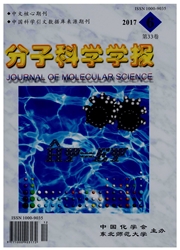

 中文摘要:
中文摘要:
应用密度泛函理论(DFT)对金属Ir4簇催化乙烯加氢反应的反应机理进行了详尽的理论研究.在B3LYP/ECPEC,H:6-311G(d)和6-31G(d);Ir:LANL2DZ]理论水平下优化了反应通道上各驻点(反应物、中间体、过渡态和产物)的几何构型,并且用组态相互作用CCSD/ECP[C,H:6-311G(d,p);Ir:LANL2DZ]计算了各驻点的单点能,构建了该反应的基态势能面.为了验证过渡态的真实性,在B3LYP/ECP理论水平下做了内禀反应坐标(IRC)计算和频率分析.计算结果表明:金属Irt簇催化乙烯加氢反应为双通道(a和b)反应,经过多个反应步骤完成;通道a:R→TSR-1→I1→TS1-2→I2→TS2-3→13→TS3-P→P为较为可行的反应通道。
 英文摘要:
英文摘要:
Using density functional theory (DFT), the reaction mechanism of ethene hydrogenated catalyzed by metalline Ir4 cluster were explored in detail theoretically. At B3LYP/ECP[C, H. 6-311G (d) Ir.LANL2DZ] level of theory, the geometries of stationary points (reactions, intermediate isomers, transition states and product) were optimized. Based on the single point energies calculated at the CCSD/ECP I-C, H: 6-311G(d,p) ; Ir:LANL2DZ]//B3LYP/ECP level of theory, the ground state potential energy surface was plotted. All the transition states are verified by the IRC calculation and frequency analysis at the B3LYP theory level. The calculated results suggested that for the ethene hydrogenation catalyzed by metal Ir4 cluster, the reaction may follow two reaction channels, which are a and b, and it is a multiple steps reaction process. The pathway a: R→TSR→1→I1→TS1-2→I2→TS2-3→I3→TS3-P→P is more feasible than pathway b on the PES on both kinetic and thermodynamic considerations.
 同期刊论文项目
同期刊论文项目
 同项目期刊论文
同项目期刊论文
 Direct ab initio dynamics study on the rate constants and kinetic isotope effect for the reactions o
Direct ab initio dynamics study on the rate constants and kinetic isotope effect for the reactions o Theoretical study on the potential energy surface of the reaction of vinyl radical (C2H3.) with hydr
Theoretical study on the potential energy surface of the reaction of vinyl radical (C2H3.) with hydr 期刊信息
期刊信息
